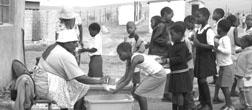Monday, August 15, 2005
The Belated ARV Roll-Out Programme
Before 2004, ARV (anti-retroviral) treatment for South Africans was limited to the affluent at private hospitals. At government run hospitals, the public occasionally received bactrim for prophylaxis and fluconazole for fungal infections in the oral cavity, but nothing to decrease the viral load of HIV. Basically most doctors could only recommend a healthy diet and vitamins. Moreover, the government did not provide barriers to HIV/AIDS – no education in schools, no treatment. Worsening the situation, the Minister of Health (a non-health care worker) apparently denied the efficacy of ARV to the public and referred people to herbal medicine. People had no incentives to get tested because rather than receiving treatment they received stigma. Thousands of infected people grew out of control by the late 90s surpassing numbers across the globe.
As a generation of people disappeared, the government took action in April 1st, 2004 by accrediting eight hospitals to provide ARV treatment free of charge. Saint Benedictine was one of the eight. Global sponsorships of medications, equipment, and facilities made free ARV possible for patients. A nongovernmental organization (NGO) built the ARV clinic and numerous pharmaceuticals supplied the medicines free or discounted. (I guess big pharma sometimes does good, but I’m always suspicious of their motives.)
The current ARV program only offers three possible regimens each containing three different medications. With only a few regimen options, South African physicians must carefully watch for resistance or else the regimens may become obsolete. Whereas the United States can provide upwards to 10 or so different regimens, providing increase flexibility in treatment and less concern for resistance.
With an estimated five-million HIV-positive people, South Africa's treatment programme might be the world's largest. The total cost of providing the drugs to everybody needing them will be between US $1 billion and $1.09 billion by 2005 and that 1.7 million lives could be saved by 2010. Otherwise up to 1.8 million more children would be orphaned by 2010 if ARVs were not provided.
After one year, many more clinics and hospitals are providing ARV therapy. Inititaly, Benedictine started an average of 7-8 patients on ARVs a week and now is up to average of 20 patients on ARVs a week. Physicians and the community have seen drastic increases in CD4 counts and greater acceptance of the ARV program, but they are still waiting to see the decrease in incidence and prevalence of HIV/AIDS which will be the true sign of success.
Unfortunately success requires an increase in the budget. The waiting area for the ARV clinic overflows into the outdoors in the mornings. In order to achieve the goal of working towards an AIDS-free society by 2020, the hospital needs to increase facilities and staff to properly treat the increased enrollment. However, the hospital doesn’t currently have the means to make such progress.
As a generation of people disappeared, the government took action in April 1st, 2004 by accrediting eight hospitals to provide ARV treatment free of charge. Saint Benedictine was one of the eight. Global sponsorships of medications, equipment, and facilities made free ARV possible for patients. A nongovernmental organization (NGO) built the ARV clinic and numerous pharmaceuticals supplied the medicines free or discounted. (I guess big pharma sometimes does good, but I’m always suspicious of their motives.)
The current ARV program only offers three possible regimens each containing three different medications. With only a few regimen options, South African physicians must carefully watch for resistance or else the regimens may become obsolete. Whereas the United States can provide upwards to 10 or so different regimens, providing increase flexibility in treatment and less concern for resistance.
With an estimated five-million HIV-positive people, South Africa's treatment programme might be the world's largest. The total cost of providing the drugs to everybody needing them will be between US $1 billion and $1.09 billion by 2005 and that 1.7 million lives could be saved by 2010. Otherwise up to 1.8 million more children would be orphaned by 2010 if ARVs were not provided.
After one year, many more clinics and hospitals are providing ARV therapy. Inititaly, Benedictine started an average of 7-8 patients on ARVs a week and now is up to average of 20 patients on ARVs a week. Physicians and the community have seen drastic increases in CD4 counts and greater acceptance of the ARV program, but they are still waiting to see the decrease in incidence and prevalence of HIV/AIDS which will be the true sign of success.
Unfortunately success requires an increase in the budget. The waiting area for the ARV clinic overflows into the outdoors in the mornings. In order to achieve the goal of working towards an AIDS-free society by 2020, the hospital needs to increase facilities and staff to properly treat the increased enrollment. However, the hospital doesn’t currently have the means to make such progress.
Subscribe to:
Post Comments (Atom)










No comments:
Post a Comment